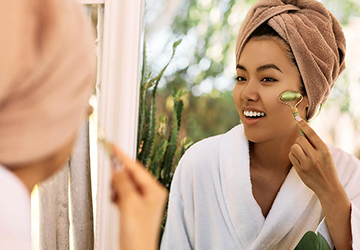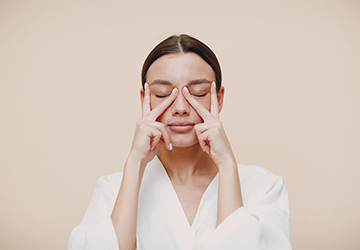Facial massages are highly rejuvenating and mindful. You can easily give yourself a facial massage at home with the right products and techniques. In this article, we will go through the benefits of facial massages and some of the best practices you can use to have a facial massage at home. Let's get started.

What is a Facial Massage?
Facial massage is a massage therapy made exclusively for the face. It relaxes the facial muscles, increases blood circulation, and encourages a general feeling of relaxation and well-being. It entails applying gentle pressure on different places of the face and employing various massage techniques.
To promote blood flow, lessen tension in the facial muscles, and increase lymphatic drainage, a professional therapist would combine manual methods, including stroking, kneading, tapping, and pressure point massage during a facial massage. However, if you wish to get all that done at home, we have you covered below!
What is the Importance of Facial Massage?
Let's look at some potential skin benefits of having a facial massage at home.
Improved Circulation and Lymphatic Drainage
Numerous ways exist for facial massage to enhance lymphatic drainage and circulation. First, massaging your face can aid in hydrating and oxygenating the skin cells by increasing blood flow to the area. A more youthful appearance may result from removing waste materials and toxins from the skin due to enhanced blood flow.
Secondly, the lymphatic system, which is in charge of expelling waste and toxins from the body, can be stimulated by facial massage. Massage can assist in promoting these muscle contractions and improve lymphatic drainage because the lymphatic system relies on them to circulate lymph fluid throughout the body. Enhanced muscle contractions can enhance the general health and appearance of the skin and lessen facial edema and puffiness.
Reduced Tension and Stress in Facial Muscles
Tight or strained facial muscles can result in discomfort, pain, and migraines. Additionally, this tension may speed up the development of wrinkles and fine lines, giving the face an older appearance than it is.
Applying little pressure to the facial muscles and tissues during a facial massage can assist in relieving tension and encourage relaxation. This pressure activates the skin's nerve endings, which can aid in easing discomfort and pain.
Improved Skin Tone and Texture
The muscles in the face can be toned and strengthened by facial massage, which can assist in improving the skin's overall appearance. Facial massage can help lift and firm sagging skin by building up the muscles, giving skin a more youthful appearance.
Reduced Appearance of Fine Lines and Wrinkles
The protein collagen is responsible for the suppleness and firmness of the skin. The stimulation of collagen production by facial massage can assist in smoothing out the skin's texture and lessen the visibility of fine lines and wrinkles.

Improved Absorption of Skincare Products
The skin can more easily absorb skincare products with facial massage. Facial massage can help provide more nutrients and active chemicals to the skin cells by boosting blood circulation and lymphatic drainage, improving skin tone and texture.
How to Prepare for a Facial Massage?
In the convenience of your own home, you can massage your face. Be sure to wash your hands and look before starting. Use a tiny bit of serum, oil, or cleansing balm to make it simple for your fingertips to glide and roll over your skin. You can also use your palm's surface.
You can combine your favorite components to make a custom facial massage paste, whether you have five minutes or an hour. Each stroke should be made five times, or you can concentrate on one spot for 20 to 30 seconds. Apply consistent but gentle pressure.
10 Facial Massage Techniques to Try at Home
Here are ten facial massage techniques you can try at home:
Effleurage: This soft stroking technique is used to warm up the face and prepare it for a more intense massage. Start at the middle of your forehead and move down to your chin with your fingertips.
Petrissage: The facial muscles are kneaded during a petrissage to increase blood flow and relieve tension. Apply light pressure with your fingertips on your cheeks while making circular strokes.
Pinching: Using your thumb and index finger, pinch and lift the skin on your jawline, cheeks, and forehead. This aids in lifting and toning the skin.
Tapping: To encourage blood flow and lymphatic drainage, wipe your forehead, cheeks, and chin gently with your fingertips.
Vibrations: Gently vibrate your chin, cheeks, and forehead with your fingertips. This may aid in easing stress and encouraging relaxation.
Friction: Apply circular motions and light pressure with your fingertips along the cheekbones and jawline to create conflict. This promotes circulation and eases strain.
Cross-fiber Friction: Apply pressure and circular motions with your fingertips across the face and forehead muscles' fibers to create cross-fiber friction. This eases tension and enhances skin tone.
Stretching: Gently stretch the skin over the cheeks and jawline using your finger bones, which aids in lifting and toning the skin.
Rolling: Roll upwards over your face using a facial roller or a small, smooth stone. This promotes circulation and lessens puffiness.
Acupressure: Apply pressure on specific pressure spots on your face, such as the temples or the space in between your brows, using your fingertips. This may aid in easing stress and encouraging relaxation.
Conclusion
Facial massages are an excellent approach to treating specific issues while healing and renewing TLC. Enjoy the learning process as you practice self-facial massage or receive regular professional treatments. Stay healthy by allowing yourself plenty of time to rest and unwind, adhering to a healthy diet, and caring for your skin.